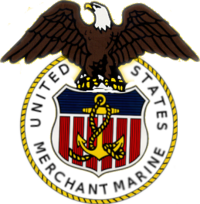US Merchant Marine
The United States Merchant Marine refers to either United States civilian mariners, or to U.S. civilian and federally owned merchant vessels. Both the civilian mariners, and the merchant vessels, are managed by a combination of the government and private sectors, and engage in commerce or transportation of goods and services in and out of the navigable waters of the United States. The Merchant Marine primarily transports cargo and passengers during peacetime; in times of war, the Merchant Marine can be an auxiliary to the United States Navy, and can be called upon to deliver military personnel and materiel for the military. Merchant Marine officers may also be commissioned as military officers by the Department of Defense. This is commonly achieved by commissioning unlimited tonnage Merchant Marine officers as Strategic Sealift Officers in the Naval Reserves.
Merchant mariners move cargo and passengers between nations and within the United States, and operate and maintain deep-sea merchant ships, tugboats, towboats, ferries, dredges, excursion vessels, charter boats and other waterborne craft on the oceans, the Great Lakes, rivers, canals, harbors, and other waterways.
As of 31 December 2016, the United States merchant fleet had 175 privately owned, oceangoing, self-propelled vessels of 1,000 gross register tons and above that carry cargo from port to port or more. Nearly 800 American-owned ships are flagged in other nations.
The federal government maintains fleets of merchant ships via organizations such as Military Sealift Command (part of the US Navy) and the National Defense Reserve Fleet, which is managed by the United States Maritime Administration. In 2004, the federal government employed approximately 5% of all American water transportation workers.
...
Wikipedia

